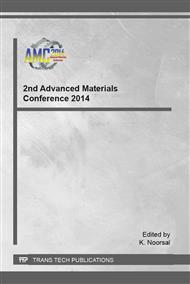p.201
p.206
p.211
p.216
p.221
p.226
p.231
p.236
p.241
Utilization of Waste Natural Rubber Latex for Cleaning Application
Abstract:
Natural Rubber (NR) latex cleaning compound was prepared by using three types of NR latex; HA latex, waste latex and subnormal latex. Each of these NR latex is then compounded with two different cleaning agents; monoethanolamine (MEA) and diethylene glycol (DEG) at three different phr loading; 1, 3 and 5 phr. The mechanical properties of these compounds were also investigated. Cleaning efficiency was conducted by applying the NR latex cleaning compound on the dirty surfaces. From the results, NR latex compounded with MEA exhibit better mechanical properties at loading of 3 phr MEA. The cleaning efficiency also showed the ability of NR latex compound to clean the dirty surfaces with addition of cleaning agent especially at higher loading. The waste N R latex compound compounded with MEA shows the best result in cleaning the surfaces due to the presence of filler that can adsorbed the dirt on the surfaces.
Info:
Periodical:
Pages:
221-225
Citation:
Online since:
January 2016
Authors:
Price:
Сopyright:
© 2016 Trans Tech Publications Ltd. All Rights Reserved
Share:
Citation:


